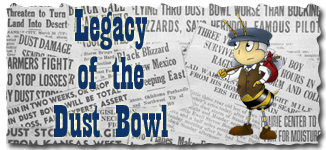
 |
"Three
little words, achingly familiar on a Western farmer's tongue, rule
life in the dust bowl of the continent - 'if it rains.' "
These activities are designed to promote critical thinking and analysis of the cultural genres during the 1930s and their impact on future generations. |
National History Standards Era 8: The Great Depression and World War II (1929-1945) Standard 1: The causes of the Great Depression and how it affected American society. Standard 1B: The student understands how American life changed during the 1930s. 5-12: Explain the effects of the Great Depression and the Dust Bowl on American farm owners, tenants, and sharecroppers. [Analyze multiple causation] |
|||
|
||||
© 1996 - 2009 Linda C. Joseph
All Rights Reserved
All CyberBee Graphics are Trademarked
Graphics by
Darlene Vanasco/Creative Director
Erika Taguchi/Designer & Illustrator
Hosting Provided by Iwaynet